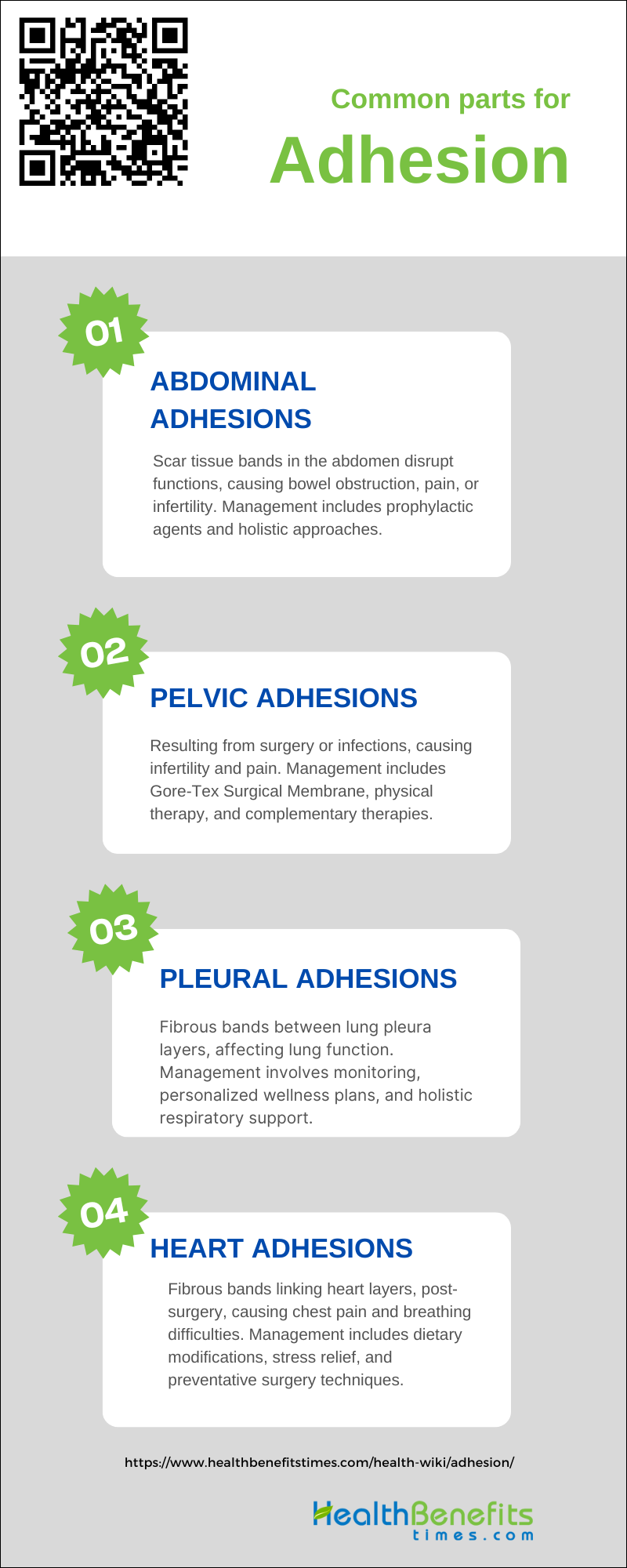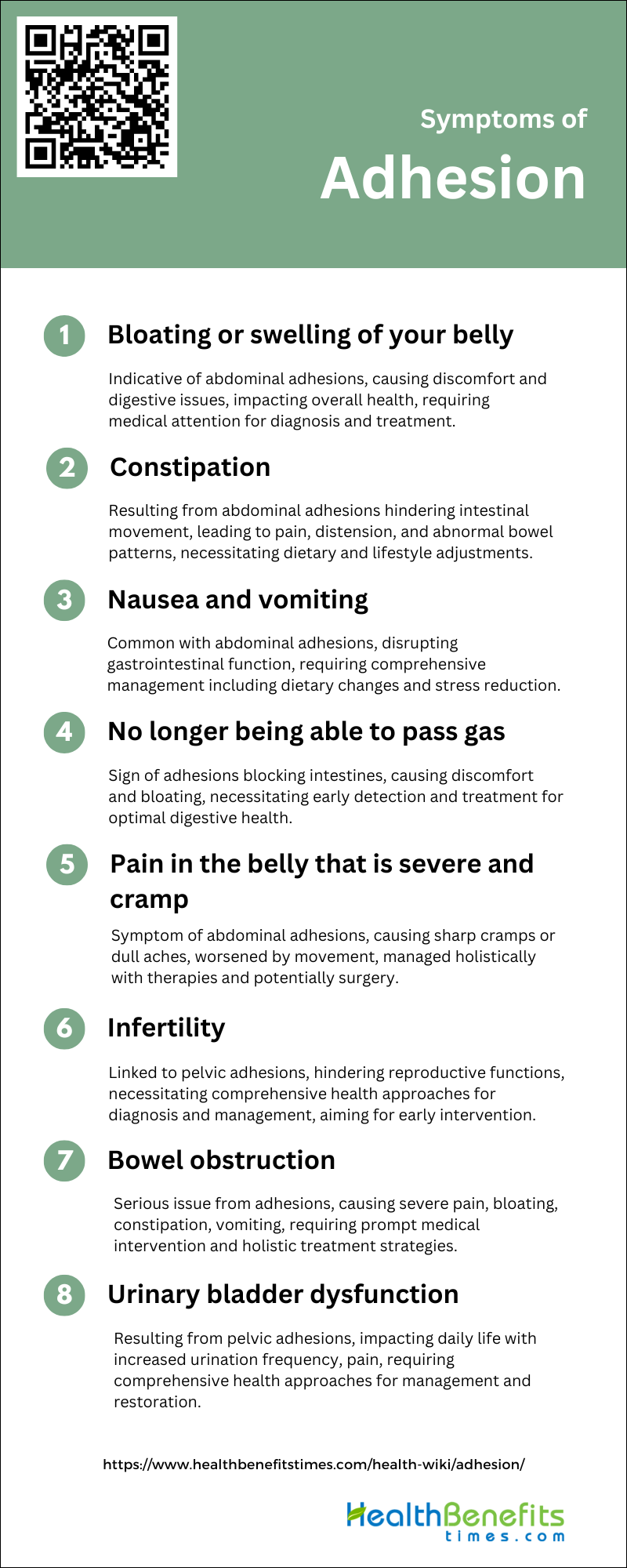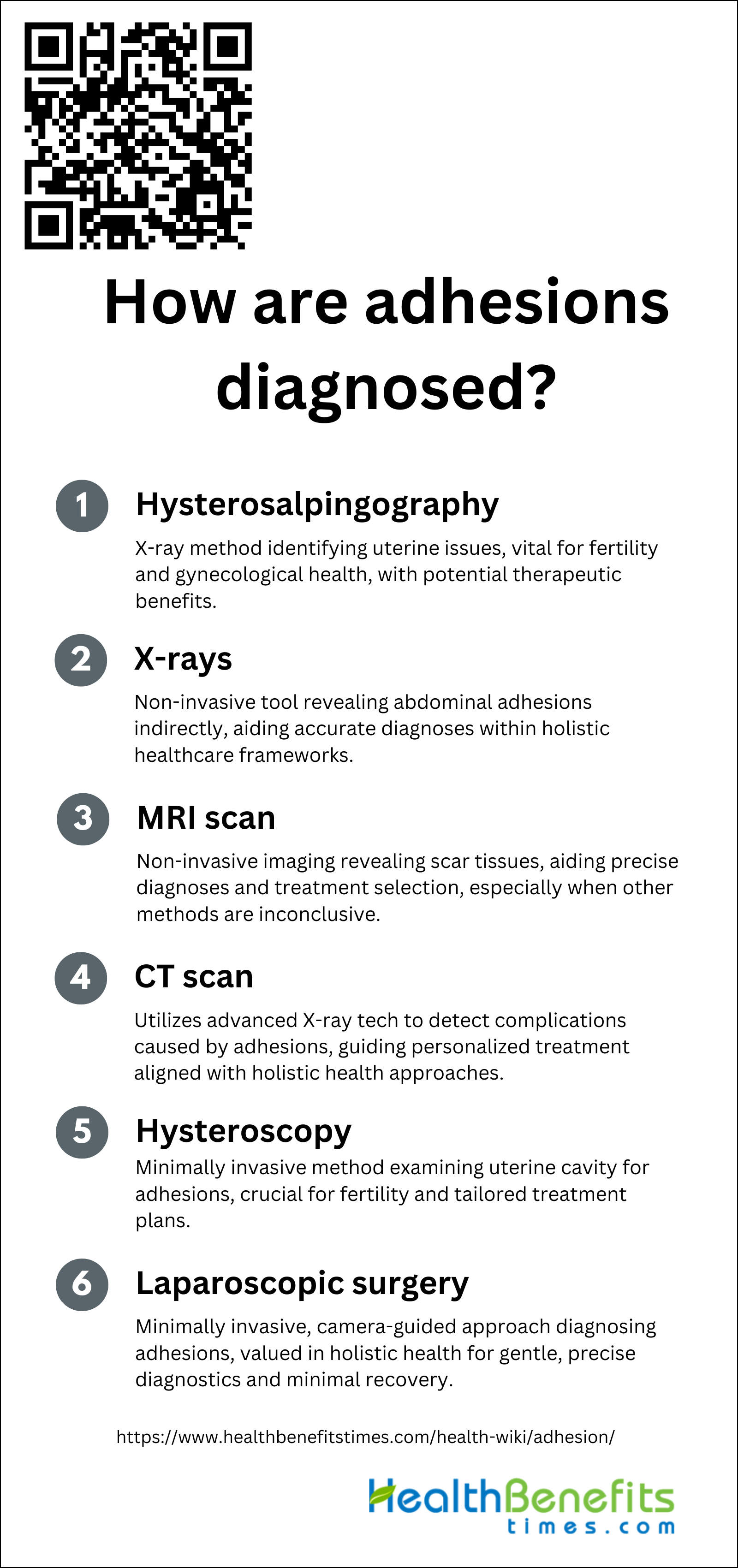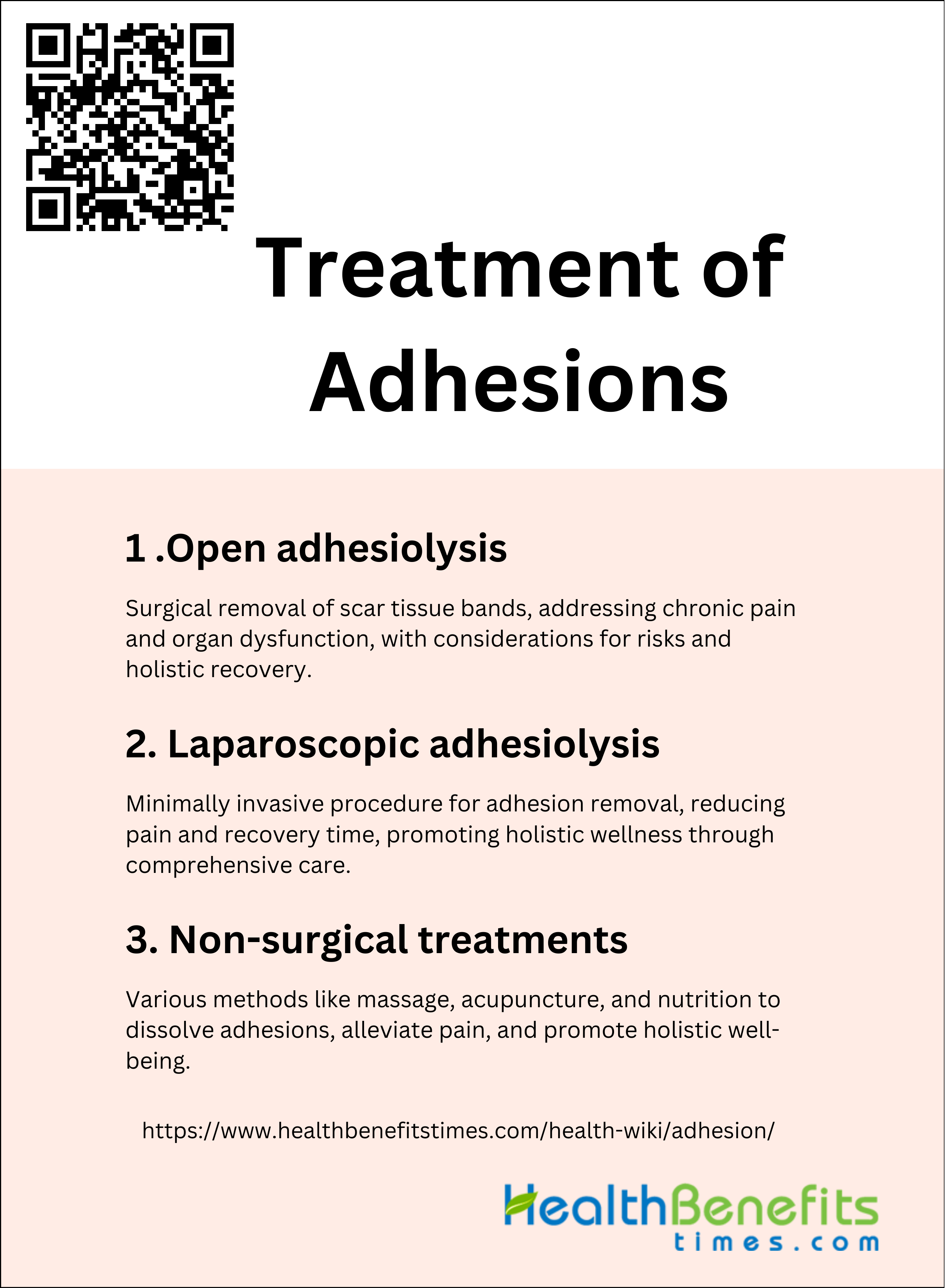 Adhesion refers to the process by which two surfaces are held together by interfacial forces which may consist of valence forces or interlocking action, or both. It is a critical property in a wide range of materials, especially polymers, where it can vary from very strong to extremely weak depending on the application, such as in adhesives or non-stick coatings. This natural phenomenon is not only a fundamental scientific concept but also a significant factor in human health. Adhesions between tissues and organs can develop as a result of healing processes following surgery, injury, or inflammation. These internal adhesions can cause discomfort and restrict movement, highlighting the importance of understanding adhesion for individuals seeking overall physical well-being. Recognizing and managing adhesion is crucial for maintaining the delicate balance necessary for optimal bodily function and wound healing, emphasizing its role in a holistic approach to health and fitness.
Adhesion refers to the process by which two surfaces are held together by interfacial forces which may consist of valence forces or interlocking action, or both. It is a critical property in a wide range of materials, especially polymers, where it can vary from very strong to extremely weak depending on the application, such as in adhesives or non-stick coatings. This natural phenomenon is not only a fundamental scientific concept but also a significant factor in human health. Adhesions between tissues and organs can develop as a result of healing processes following surgery, injury, or inflammation. These internal adhesions can cause discomfort and restrict movement, highlighting the importance of understanding adhesion for individuals seeking overall physical well-being. Recognizing and managing adhesion is crucial for maintaining the delicate balance necessary for optimal bodily function and wound healing, emphasizing its role in a holistic approach to health and fitness.
Common parts for adhesion
Understanding the common components that contribute to effective adhesion can improve the functionality and comfort of health-related products. The following are the key elements to consider:
1. Abdominal adhesions
Abdominal adhesions are dense bands of scar tissue in the abdomen that can disrupt the body’s natural functions, often as a result of surgery, trauma, or inflammation. These adhesions can lead to complications such as bowel obstruction, chronic pain, or infertility, highlighting the importance of recognizing symptoms like abdominal discomfort and changes in bowel habits. Studies have explored various prophylactic agents, like A-Part Gel, to prevent such adhesions after abdominal surgeries. Holistic health approaches focus on treating the entire body and may involve physical therapy, massage, or minimally invasive surgery to manage adhesions. By addressing these internal disruptions, holistic practices aim to restore balance and improve overall well-being. Understanding and managing the effects of adhesions is crucial for maintaining a healthy, integrated body system.
2. Pelvic adhesions
Pelvic adhesions, often a consequence of surgery, can lead to complications such as infertility and chronic pain. The Gore-Tex Surgical Membrane has shown promise in reducing post-radical pelvic surgery adhesions (PRPSA) by acting as a barrier, significantly lowering adhesion scores and small bowel adherence in the pelvis. They often result from surgery, infections, or conditions such as endometriosis. A comprehensive approach to managing pelvic adhesions involves physical therapy, dietary modifications to reduce inflammation, and, in severe cases, surgery. Complementary therapies like acupuncture, herbal remedies, and stress-reduction techniques can also contribute to improving pelvic health and alleviating discomfort. It is crucial for individuals affected by pelvic adhesions to work closely with healthcare professionals to develop a personalized treatment plan that addresses both immediate symptoms and long-term well-being. Early detection of symptoms and seeking specialized care are essential for effectively managing the condition and maintaining a healthy, active lifestyle.
3. Pleural adhesions
Pleural adhesions are fibrous bands that form between the layers of the pleura surrounding the lungs. Pleural adhesions, commonly found in autopsies, are more prevalent in older males and those with a history of tuberculosis, indicating their potential as markers for tuberculosis control effectiveness. They can result from surgery, infections, trauma, or inflammation, potentially impairing lung function and causing discomfort. While not all individuals with pleural adhesions exhibit symptoms, those who do may experience restricted lung expansion and respiratory difficulties It is crucial for individuals with pleural adhesions to work closely with healthcare providers to monitor their health and develop a personalized wellness plan that supports respiratory function and overall well-being. Understanding and managing pleural adhesions are essential for preventing respiratory complications and promoting a holistic approach to health.
4. Heart adhesions
Heart adhesions, fibrous bands that abnormally connect the heart’s outer layer to nearby structures, present a challenge to cardiac health, particularly post-surgery. These adhesions, often resulting from surgical trauma, infections, or inflammation, can cause symptoms such as chest pain and breathing difficulties, and may impede heart function or complicate future procedures. To address this condition within a holistic health framework, a comprehensive approach is recommended, including dietary modifications to include anti-inflammatory foods, supplements like omega-3s and antioxidants, and stress-relief practices such as yoga or meditation. Preventative measures during surgery, such as the use of barrier films and precise surgical techniques, are also crucial. Collaborating closely with healthcare professionals to tailor a wellness plan is essential for individuals affected by heart adhesions, ensuring their unique health needs are addressed and cardiac health is optimized.
Causes of Adhesion
Adhesions are fibrous bands that develop between tissues and organs, typically following surgery, trauma, or inflammation. These internal scars can result in complications such as pain, limited movement, and organ dysfunction. Recognizing the factors contributing to adhesion formation is essential for prevention and treatment, particularly in holistic health approaches that prioritize overall well-being.
- Appendicitis
- Cancer
- Endometriosis
- Infections in the abdomen and pelvis
- Radiation treatment
- After surgery or trauma
- With certain types of arthritis
- With overuse of a joint or tendon
Symptoms of Adhesion
Adhesions are fibrous bands that connect tissues and organs that are not typically connected, often resulting in discomfort and various symptoms. These symptoms can include severe abdominal pain, bloating, and changes in bowel habits, significantly affecting daily activities and overall well-being. Recognizing these symptoms is essential for early detection and effective management.
1. Bloating or swelling of your belly
Abdominal bloating and swelling can often indicate the presence of adhesions, which are fibrous bands that may form between abdominal tissues and organs following surgery or inflammation. These adhesions can cause discomfort and digestive issues, leading to feelings of fullness or tightness and potentially disrupting organ function, impacting overall health. It is important for individuals experiencing these symptoms to seek medical advice for an accurate diagnosis and appropriate treatment. A combination of traditional and holistic therapies can effectively alleviate discomfort and restore the body’s natural balance, improving overall well-being and quality of life. Understanding and managing the effects of adhesions on the body is crucial for achieving optimal health and wellness.
2. Constipation
Constipation, a common discomfort, often arises from adhesions in the abdominal or pelvic regions, which are scar-like tissues that can hinder intestinal movement. It can manifest as abdominal distension, pain, and abnormal bowel movement patterns, which may be intermittent or episodic. Adhesions can lead to small bowel obstruction, exacerbating constipation and related urinary symptoms. This can lead to a sluggish digestive process, characterized by infrequent or difficult bowel movements and a sensation of incomplete emptying. To comprehensively address this condition, individuals may consider implementing dietary modifications to increase fiber intake, ensuring adequate hydration, participating in regular physical activity, and practicing stress management techniques. It is crucial to identify and treat the root causes of adhesion-induced constipation, as it can significantly impact an individual’s overall health and well-being. Seeking guidance from a healthcare professional is essential for personalized advice and effective treatment options.
3. Nausea and vomiting
Nausea and vomiting are common symptoms of abdominal adhesive disease, often resulting from post-surgical adhesions. The fibrous bands of scar tissue that can adhere internal organs together often result in nausea and vomiting by disrupting the normal function of the gastrointestinal tract. These symptoms can vary from intermittent to persistent and may be exacerbated by specific activities or foods. When adhesions lead to blockages in the intestines, the resulting accumulation can exacerbate the discomfort, and in severe cases, such as bowel strangulation, immediate medical attention is crucial to prevent serious complications. A comprehensive health approach to managing these symptoms involves identifying the root causes and implementing strategies such as dietary modifications, stress reduction, and alternative therapies to improve digestive health and alleviate the unpleasant sensations.
4. No longer being able to pass gas
The inability to pass gas, often overlooked, is a significant symptom that may indicate the presence of adhesions – bands of scar tissue that can cause organs to adhere together and disrupt normal bodily functions. These adhesions can block the intestines, leading to gas accumulation, bloating, and discomfort, and may indicate a partial or complete bowel obstruction. Recognizing this symptom is crucial as it reflects the health of the gastrointestinal tract, an important aspect of overall well-being. Early detection is essential for comprehensive health care, as it promotes timely investigation and treatment strategies to restore the body’s balance and optimize digestive system function.
5. Pain in the belly that is severe and cramp
Severe and cramp-like abdominal pain can be a symptom of abdominal adhesions, which are internal scar tissues formed as a response to surgery or inflammation. These adhesions can cause organs and tissues to adhere together, resulting in discomfort that may present as sharp, intermittent spasms or a persistent dull ache. The pain is often worsened by movements that strain the adhesions, such as twisting, stretching, or common activities like walking or bending. In a holistic health perspective, it is important to recognize this pain as a signal from the body indicating internal issues. Managing adhesion-related pain typically involves a comprehensive approach, including physical therapy, dietary modifications, and potentially surgical intervention to release the adhesions, all aimed at restoring the body’s natural equilibrium and reducing discomfort.
6. Infertility
Infertility, a common issue for individuals with pelvic adhesions, occurs when bands of scar tissue disrupt reproductive functions. These adhesions can result from surgery, infection, or other trauma, and may obstruct fallopian tubes in women or impact sperm function in men. A comprehensive health approach is essential in addressing this problem, as it takes into account the body’s interconnected systems. By incorporating various strategies such as dietary modifications, stress management, and alternative therapies, individuals can improve their reproductive health and address the underlying causes of infertility and adhesions. Early detection and intervention are crucial, as they significantly increase the chances of achieving a successful pregnancy.
7. Bowel obstruction
Bowel obstruction, a serious health issue often associated with adhesions (scar tissue bands that form after surgery, infection, or inflammation), can result in severe abdominal pain, bloating, constipation, vomiting, and an inability to pass gas or stools. Studies show that lower gastrointestinal surgeries and the severity of existing adhesions increase the risk of bowel obstruction. These symptoms can occur suddenly or develop gradually and can vary in intensity. Early recognition and medical intervention are crucial in a comprehensive health approach to prevent the condition from worsening, as untreated obstructions can lead to serious complications such as reduced blood flow to the intestines and potentially life-threatening problems. Treatment typically involves medical procedures along with holistic therapies aimed at reducing inflammation and improving digestive health.
8. Urinary bladder dysfunction
Urinary bladder dysfunction, often a distressing consequence of adhesions in the pelvic region, can significantly impact daily life with symptoms such as increased frequency of urination, sensation of incomplete voiding, pain, and nocturnal awakenings. These issues not only result in discomfort but also underscore the interconnected nature of our bodily systems, underscoring the importance of a comprehensive approach to health. Urinary bladder dysfunction in the context of adhesions can manifest as urinary incontinence in postmenopausal women, as highlighted in a case study where labial adhesions were the primary complaint. To enhance quality of life and restore urinary health, it is crucial to address the underlying cause—pelvic adhesions—through a combination of therapeutic exercises, dietary modifications, and manual therapies like myofascial release. These interventions can alleviate symptoms and normalize bladder function, promoting overall pelvic well-being.
How are adhesions diagnosed?
Adhesions are fibrous bands that form between tissues and organs, often after surgery. They can be difficult to diagnose due to their internal nature and the range of symptoms they may cause. Understanding integrative approaches to identifying these internal scar tissues is important on a holistic health, fitness, and wellness-focused website. In the following section, we describe the primary diagnostic methods that healthcare professionals use to detect adhesions, combining conventional medical techniques with a holistic approach to patient care.
1. Hysterosalpingography
Hysterosalpingography (HSG) is a key diagnostic X-ray procedure widely used in reproductive health to identify uterine adhesions that can hinder fertility and contribute to gynecological problems. By injecting a contrast dye into the uterine cavity, it allows health practitioners to visualize the uterus and fallopian tubes, detecting any irregularities that may indicate blockages. Hysterosalpingography (HSG) is a radiographic diagnostic tool used to evaluate the patency of fallopian tubes and the presence of peritubal adhesions in infertile women. Not only does HSG help in diagnosing these issues, but it can also serve as a therapeutic intervention, as the dye may dislodge minor adhesions, improving fertility prospects. This technique is especially valuable in holistic health for its ability to reveal and potentially treat internal obstacles to a woman’s reproductive wellness, making it an essential step in managing fertility and related concerns.
2. X-rays
X-rays are a valuable non-invasive tool for diagnosing adhesions, which are fibrous bands that can potentially cause abdominal pain and obstructions. X-rays, or roentgen rays, are a valuable diagnostic tool for identifying adhesions in the upper right abdomen. Although X-rays do not directly show adhesions, they can indicate their presence by revealing dilated intestinal loops or blockages. This information helps healthcare providers make accurate diagnoses and distinguish adhesions from other abdominal issues. A thorough health assessment, combined with these imaging findings, enables personalized and holistic treatment plans that take into account the patient’s overall physical and emotional well-being. If X-ray results suggest adhesions, additional imaging techniques such as ultrasounds or CT scans may be used for a more definitive evaluation. This integrated diagnostic approach highlights the importance of minimally invasive methods in promoting patient health within a holistic healthcare framework.
3. MRI scan
An MRI scan is a non-invasive imaging technique that utilizes a magnetic field and radio waves to generate detailed images of the internal structures of the body. This technology aids healthcare providers in identifying adhesions, which are areas of scar tissue that can develop following surgery or as a result of certain diseases, without the need for invasive procedures. Magnetic Resonance Imaging (MRI) has proven to be a valuable non-invasive tool for diagnosing intra-abdominal adhesions. The high-resolution images produced by MRI scans are essential for visualizing soft tissues and assisting in the selection of appropriate treatment options, whether traditional or integrative, to support overall health and well-being. While MRIs are commonly used in medical imaging, they may not always directly display abdominal adhesions. Instead, the presence of adhesions is often inferred by observing indirect indicators, such as displacement of organs. In cases where X-rays or ultrasounds do not provide a definitive diagnosis, MRIs can offer greater clarity. However, in some instances, laparoscopic surgery may be required for a conclusive diagnosis and potential treatment of these fibrous bands.
4. CT scan
CT scans are an essential diagnostic tool for detecting the indirect signs of adhesions, which are tough bands of scar tissue that can disrupt organ function. These scans utilize advanced X-ray technology to generate detailed images of the body’s internal structures, aiding healthcare professionals in identifying complications such as bowel obstructions or ischemia that may result from adhesions. While adhesions themselves are not typically visible on a CT scan, the technique is crucial for detecting the symptoms they cause, such as sudden changes in bowel structure. By providing a clear and comprehensive view of the body’s interior, CT scans play a key role in developing personalized treatment plans tailored to each patient’s specific physiological needs, ensuring that care is aligned with the holistic approach of promoting overall health and wellness.
5. Hysteroscopy
Hysteroscopy is a necessary, minimally invasive diagnostic procedure that allows for a clear visual examination of the uterine cavity, which is essential for detecting intrauterine adhesions. By inserting a hysteroscope—a thin instrument with lighting—through the cervix, healthcare providers can observe the uterus and fallopian tube openings in real-time, identifying the location and severity of any adhesions. These adhesions can result in abnormal menstrual patterns or infertility, and understanding their extent through hysteroscopy is crucial for individuals seeking comprehensive health solutions. The procedure not only aids in diagnosis but also guides the management and treatment strategies, such as addressing Asherman’s syndrome, ultimately improving reproductive health and aligning with individual wellness objectives.
6. Laparoscopic surgery
Laparoscopic surgery is a key diagnostic approach for detecting adhesions, the fibrous bands that may develop between tissues and organs after surgery or inflammation. This minimally invasive technique involves small incisions and the use of a laparoscope, a camera-equipped tube, to provide a clear view inside the abdomen, identifying adhesions and assessing their impact on health. It is especially appreciated in the holistic health, fitness, and wellness community for its gentle approach, aligning with the values of reducing harm and supporting overall well-being. Laparoscopy offers precise diagnostics with minimal recovery time, helping to uncover and address the underlying causes of chronic pain and other symptoms, where other methods like X-rays or ultrasounds might not suffice.
Treatment of adhesions
Below, we investigate several natural and integrative strategies designed to manage and treat adhesions, enhance wellness, and support the body’s natural healing mechanisms.
1. Open adhesiolysis
Open adhesiolysis is a crucial surgical procedure utilized to address adhesions, which are bands of scar tissue that can lead to chronic pain, bowel obstructions, or fertility issues by abnormally connecting internal tissues and organs. This intervention, typically considered as a final option after less invasive treatments have been unsuccessful, entails a surgeon creating an incision to excise these adhesions with the goal of restoring normal bodily function and alleviating discomfort. Despite the potential for immediate relief, caution is advised when approaching this procedure due to the risks associated with open surgery and the potential for new adhesions to form post-operatively. When discussing open adhesiolysis on a holistic health and wellness platform, it is essential to not only focus on the surgical aspect but also consider preventive measures, post-operative care, and complementary therapies that can aid in the body’s healing process and maintain overall balance and well-being. The decision to proceed with open adhesiolysis should be made with a comprehensive understanding of the patient’s health status, ensuring that the benefits outweigh the risks in the pursuit of long-term health and harmony.
2. Laparoscopic adhesiolysis
Laparoscopic adhesiolysis is a minimally invasive procedure that provides significant relief from chronic pain, bowel obstructions, and infertility caused by adhesions, which are bands of scar tissue that improperly connect internal tissues and organs. Surgeons use small incisions and a laparoscope with a camera to carefully cut these fibrous connections, restoring normal organ function and reducing discomfort. This technique is preferred over traditional open surgery because it allows for a faster recovery time, reduces the risk of infection, and minimizes postoperative pain. Patients are encouraged to incorporate balanced nutrition, physical therapy, and stress reduction techniques into their recovery plan to improve overall well-being. Choosing laparoscopic adhesiolysis can effectively alleviate symptoms with minimal disruption to daily life, aligning well with a holistic approach to health, fitness, and wellness.
3. Non-surgical treatments
Various studies have explored non-surgical treatments for adhesions, focusing on preventing their formation and re-formation after surgery. Research has discovered several compounds that show promise in reducing postoperative adhesions. For example, a study found that administering substances like taurolidine, plasmin/DNase, streptokinase/streptodornase, phosphatidylcholine, hyaluronic acid, sphingolipid, galactolipid, and tetrachlorodecaoxide significantly reduced adhesion formation in rabbits. [Link] Aspirin, a non-steroidal anti-inflammatory drug, also showed potential in preventing adhesion formation when given in low doses over a long period in rodents. N,O-carboxymethyl chitosan (NOCC) has effectively limited adhesion formation and re-formation, acting as a biophysical barrier. Additionally, using a combination of carboxymethylcellulose and heparin has been suggested as a cost-effective intervention that should be tested in human clinical trials.





